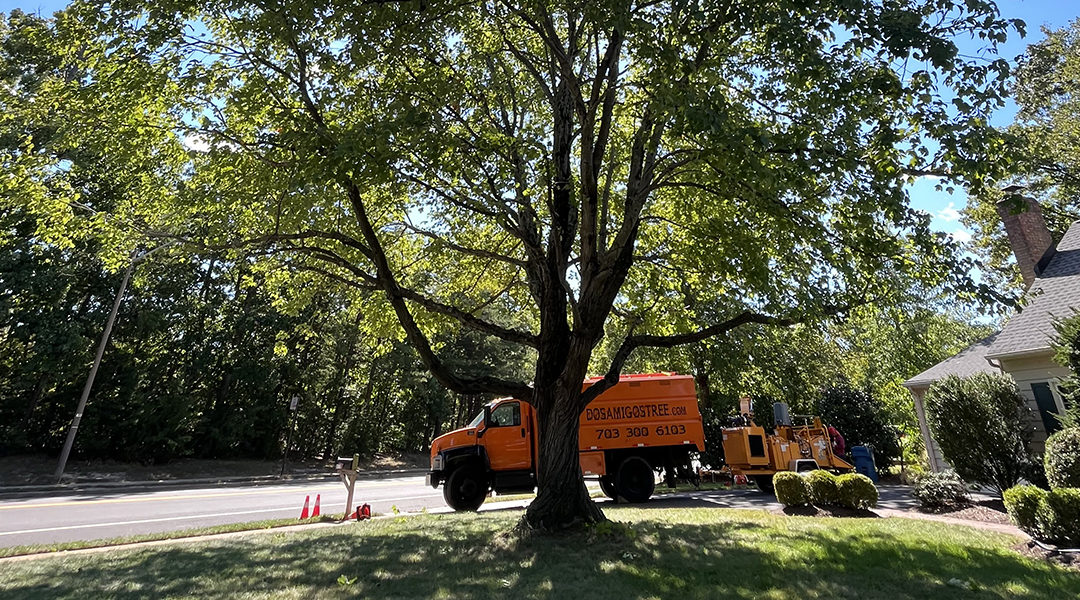Every year, the tree care professionals at Dos Amigos Tree Experts answer questions from Virginia locals about mulching around trees. What best practices do we follow to get our trees through winters and dry periods? As Alexandria’s mulching experts, we are proud to be able to provide some helpful answers so that homeowners and business owners can keep their trees healthy.
What do you need to know about mulching? In this explainer, our tree care experts debunk three of the most widespread myths about mulching so that you don’t fall into tree care practices that could kill your trees.
Myth #1 Adding More Mulch is Always Better
If you look around any residential suburbs in Alexandria, VA, you might notice homes with wood shavings stacked underneath the trees in the yard. Arborists call this practice volcano mulching, which some professional landscapers use to try and saturate the topsoil with mulch and protect newly planted trees from adverse weather.
These mulch layers can reach 12 inches to half a meter high, becoming visually prominent, even in areas with lots of grass. Landscapers build mulch volcanoes for aesthetic effect, adding texture to a monotonous front yard with synthetic mulching materials like landscape fabric, stone, or plastics. Whatever the reason, our tree care professionals do not recommend this practice.
It is true that mulch helps soil retain moisture, but too much water will prevent vital oxygen from traveling to your tree’s roots. Homeowners who resort to volcano mulching often find rotting tree roots protruding from the ground after a few months because they break the surface to breathe when they cannot source oxygen from the subsoil. Exposed roots also expose the tree to rot, mold, and animal damage for dire results.
Mulch in moderation is helpful, though. For example, Alexandria, VA, averages rainfall of around 40 inches per year, and the right amount of mulch in early spring should prevent erosion.
Myth #2 Mulching Makes Termite Infestations More Likely
Farmers and manufacturers make organic mulch from wood shavings, but will it attract termites that could infest a home or destroy the gardens? Termites, like any insect, love damp and dark spaces. However, they only infest buildings and trees with pre-existing vulnerabilities like foundation leaks, a history of flooding, and sagging drywall.
Most trees develop resistance against insect pests early on. They will only be vulnerable to termites when they suffer health problems or start to get decaying branches.
To prevent moisture damage to walls and foundations, tree care professionals recommend a six-inch strip of dry, bare soil between your mulch and a nearby building. Mulching around trees won’t attract termites, but it will reduce the tree’s watering needs.
Myth #3 Mulching Might Harm Your Pets
Cats and dogs are notorious for finding new garden installations and chewing, scratching, or wearing them down to nothing. Can mulch harm pets when manufacturers use decomposing organic materials? It’s unlikely.
While synthetic mulches like polyethylene film, landscaping fabric, and colored plastic could be toxic to pets, straw, wood chips, and evergreen needs will only cause slight indigestion, at worst. However, one problematic mulch material to avoid for pets is cocoa chips, exclusively used in raised beds and planters.
Contact Us
Extensive experience in Virginia tree care means Dos Amigos Tree Experts fully appreciate the extent to which proper mulching preserves soil fertility. It is an essential practice in urban and farming environments where plants and animals compete for limited nutrient sources. However, the benefits of mulch do not stop at preserving moisture and soil nutrition through summers or droughts.
Would you like to learn more? Call Dos Amigos Tree Experts at (703) 300-6103 today for more about mulching around trees and other professional tree services.


